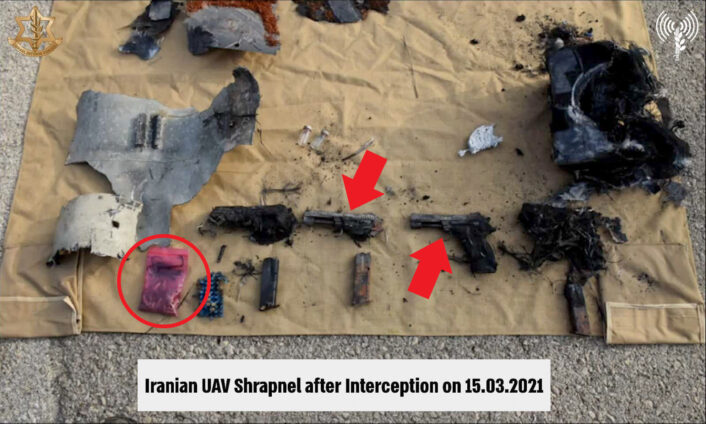The Israeli Adirs became the first F-35s to destroy airborne targets last year.
The Israeli Air Force disclosed on Mar. 6, 2022, that last year its F-35I Adir 5th gen aircraft became the first F-35s to shoot down an airborne target. This first air-to-air engagement happened on Mar. 15, 2021, with the F-35s intercepting two Iranian UAVs (Unmanned Aerial Vehicle), that were headed for the Israeli airspace, even before they crossed the border.
“The IDF activity was carried out far from the border and did not threaten civilians or facilities”, said a spokesman. “UAV interceptions were carried out in the area’s skies in coordination with neighboring countries, thus preventing intrusion into Israel. The UAVs were monitoring the control and detection systems throughout their flight.” Both drones were destroyed by using unspecified missiles: the Israeli F-35I Adir is only known to operate the infra-red guided AIM-9X air-to-air missile and the radar guided AIM-120 AMRAAM. It is probable that radar guided missiles were used in the intercept of the Iranian drones.
In March 2021, IAF F-35I “Adir” fighter jets successfully intercepted two Iranian UAVs launched towards Israeli territory.
The UAVs were successfully intercepted, making it the worlds first operational UAV interception by an F-35. pic.twitter.com/HW08fYxlkj
— Israeli Air Force (@IAFsite) March 6, 2022
Israel has established a regional air defense program in cooperation with some of its neighboring countries to detect and intercept unmanned aerial vehicles and cruise missiles, with countries mutually assisting the defense of the others. Because of this program, the two drones were detected in advance, prompting the scramble of F-35Is, belonging to the 140th “Golden Eagle” Squadron and 116th “Lions of the South” Squadron, from Nevatim Airbase.
One drone, which was reported flying towards Israel from the South, was detected at around 1:44 a.m. and was shot down at 2:19 a.m. The second one, which was flying towards Israel from the East, was detected at 1:46 a.m. and shot down at 2:16 a.m. The IDF said it is not known where the two drones were launched from, but they “were detected and tracked throughout their flight by ground control units.”
Making History:
Last year, Israeli “Adir” (F-35I) fighter jets successfully intercepted two Iranian UAVs launched towards Israeli territory. pic.twitter.com/FQsEjKzxct
— Israeli Air Force (@IAFsite) March 7, 2022
The two UAVs were identified by the military as Shahed 197 drones which were ferrying weapons to the Gaza Strip. Indeed, one photo showed drone wreckage with several pistols amongst the debris: the drones were actually carrying small arms likely for use by militant insurgents.

The fragments of the destroyed UAVs were collected and documented by the country where the engagement happened and then shared with the IDF. The Shahed 197 is one of the many drones developed by Iran after they reverse engineered the RQ-170 that crashed in the country in 2011.
According to the IDF, the Shahed 197 is powered by a micro-turbojet engine and has an endurance of 20 hours, a combat range of 2,000 km and a top speed of 2000 km/h. The drone is reportedly 7 meters wide and has a load capacity of dozens of kilograms. It is worth noting however that the drone in the video recorded by the F-35s appear to have a propeller. Either way, this drone is still part of the Shahed-161 family of flying-wing unmanned aerial vehicles which emerged in the last few years.
The IDF publishes footage of F-35 jets intercepting two Iranian drones on March 15, 2021. The military believes the drones were heading to the Gaza Strip and West Bank, based on their flight path. pic.twitter.com/HlKwtSf448
— Emanuel (Mannie) Fabian (@manniefabian) March 7, 2022
As we already reported, once they got their hands on the RQ-170, the Iranians immediately started to reverse-engineer the aircraft, creating a full-scale exact copy that they called Shahed 171 Simorgh (Phoenix), unveiled in 2014. Another copy of the RQ-170 is the scaled down, about 60% of the original size, Shahed 161, called also Saegheh (Thunderbolt) and unveiled in 2016. This drone presents some differences, mainly the absence of the two fairings on the sides of the air intake and landing gear, and can be armed with four Sadid-1 TV-guided anti-tank missiles mounted semi-recessed under the fuselage.
After that, the next to be developed were the two drones seen during the 2020 exercise “Great Prophet 14”, the Shahed 181 and Shahed 191, both called also Saegheh-2, which are essentially the same aircraft except for the engine and weapons’ placement. Like the S-161, both UAVs are smaller than the original RQ-170 copy. Some analysts suggest that the drones may be made of fiberglass.
The S-191 is powered by a micro turbojet engine which Iranian media claim is capable of pushing the UAV up to 300 km/h at 25000 ft, with an endurance of 4.5 hours and a combat radius of 450 km. As it can be noted, the performance stated by the IDF for the Shahed 197 seems much higher than the S-191 and the other Iranian drones already known.

Anyway, this week’s reveal of last year’s aerial interception by Israeli F-35Is of Iranian drones confirms two things: firstly, that Israel has kept operational missions of its advanced F-35I Adir force a closely guarded secret, and, that other missions including strike and additional air-to-air engagements may still remain classified.














